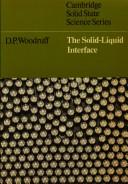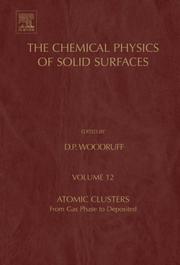| Listing 1 - 10 of 20 | << page >> |
Sort by
|

ISBN: 0521201233 9780521201230 Year: 1973 Publisher: Cambridge Cambridge University Press
Abstract | Keywords | Export | Availability | Bookmark
 Loading...
Loading...Choose an application
- Reference Manager
- EndNote
- RefWorks (Direct export to RefWorks)
Mechanical properties of solids --- Surface chemistry --- Crystal growth --- Solid-liquid interfaces

ISBN: 1281222682 9786611222680 0080475957 0444527567 9780444527561 9780080475950 Year: 2007 Publisher: Amsterdam ; Boston : Elsevier,
Abstract | Keywords | Export | Availability | Bookmark
 Loading...
Loading...Choose an application
- Reference Manager
- EndNote
- RefWorks (Direct export to RefWorks)
Atomic Clusters: From Gas Phase to Deposited brings together a series of chapters, prepared by acknowledged experts in their fields. Both fundamental and practical aspects are addressed of the physics and chemistry of a novel state of matter, namely clusters of small numbers of atoms of nanometre dimensions. This is a field of nanoscience that existed before the word was invented, but has particularly achieved major advances in the recent years.* Contributions from leading experts in solid surfaces research* Cluster science is concerned with the properties of materials on th
Microclusters. --- Atoms. --- Chemistry, Physical and theoretical --- Matter --- Stereochemistry --- Atomic clusters --- Clusters, Atomic --- Clusters, Molecular --- Microcluster physics --- Molecular clusters --- Atoms --- Microphysics --- Constitution
Book
ISBN: 1316995747 1108100430 1108103235 Year: 2021 Publisher: Cambridge : Cambridge University Press,
Abstract | Keywords | Export | Availability | Bookmark
 Loading...
Loading...Choose an application
- Reference Manager
- EndNote
- RefWorks (Direct export to RefWorks)
Learn about the properties of synchrotron radiation and its wide range of applications in physics, materials science and chemistry with this invaluable reference. This thorough text describes the physical principles of the subject, its source and methods of delivery to the sample, as well as the different techniques that use synchrotron radiation to analyse the electronic properties and structure of crystalline and non-crystalline materials and surfaces. Explains applications to study the structure and electronic properties of materials on a microscopic, nanoscopic and atomic scale. An excellent resource for current and future users of these facilities, showing how the available techniques can complement information obtained in users' home laboratories. Perfect for graduate and senior undergraduate students taking specialist courses in synchrotron radiation, in addition to new and established researchers in the field.
Book
ISBN: 9781107189805 9781316995747 Year: 2021 Publisher: Cambridge Cambridge University Press
Abstract | Keywords | Export | Availability | Bookmark
 Loading...
Loading...Choose an application
- Reference Manager
- EndNote
- RefWorks (Direct export to RefWorks)
Learn about the properties of synchrotron radiation and its wide range of applications in physics, materials science and chemistry with this invaluable reference. This thorough text describes the physical principles of the subject, its source and methods of delivery to the sample, as well as the different techniques that use synchrotron radiation to analyse the electronic properties and structure of crystalline and non-crystalline materials and surfaces. Explains applications to study the structure and electronic properties of materials on a microscopic, nanoscopic and atomic scale. An excellent resource for current and future users of these facilities, showing how the available techniques can complement information obtained in users' home laboratories. Perfect for graduate and senior undergraduate students taking specialist courses in synchrotron radiation, in addition to new and established researchers in the field.

ISBN: 9780444527561 0444527567 9780080475950 0080475957 Year: 2007 Publisher: Amsterdam Elsevier
Abstract | Keywords | Export | Availability | Bookmark
 Loading...
Loading...Choose an application
- Reference Manager
- EndNote
- RefWorks (Direct export to RefWorks)
Atomic Clusters: From Gas Phase to Deposited brings together a series of chapters, prepared by acknowledged experts in their fields. Both fundamental and practical aspects are addressed of the physics and chemistry of a novel state of matter, namely clusters of small numbers of atoms of nanometre dimensions. This is a field of nanoscience that existed before the word was invented, but has particularly achieved major advances in the recent years. * Contributions from leading experts in solid surfaces research * Cluster science is concerned with the properties of materials on the nano-metre scale * Brings together work on both free (gas-phase) clusters and those deposited on surfaces.
Book
ISBN: 131677595X 1316777499 Year: 2016 Publisher: Cambridge : Cambridge University Press,
Abstract | Keywords | Export | Availability | Bookmark
 Loading...
Loading...Choose an application
- Reference Manager
- EndNote
- RefWorks (Direct export to RefWorks)
This fully revised, updated and reorganised third edition provides a thorough introduction to the characterisation techniques used in surface science and nanoscience today. Each chapter brings together and compares the different techniques used to address a particular research question, including how to determine the surface composition, surface structure, surface electronic structure, surface microstructure at different length scales (down to sub-molecular), and the molecular character of adsorbates and their adsorption or reaction properties. Readers will easily understand the relative strengths and limitations of the techniques available to them and, ultimately, will be able to select the most suitable techniques for their own particular research purposes. This is an essential resource for researchers and practitioners performing materials analysis, and for senior undergraduate students looking to gain a clear understanding of the underlying principles and applications of the different characterisation techniques used in the field today.
Surfaces (Physics) --- Surface chemistry --- Spectrum analysis. --- Technique.
Book
ISBN: 9781139149716 9781107023109 Year: 2016 Publisher: Cambridge Cambridge University Press
Abstract | Keywords | Export | Availability | Bookmark
 Loading...
Loading...Choose an application
- Reference Manager
- EndNote
- RefWorks (Direct export to RefWorks)

ISBN: 0444419713 9780444507457 0444507450 0080542123 9780080542126 9780444511522 9780444514370 0444514376 0080498345 9780080498348 9780080532677 0080532675 1281145009 9786611145002 0444419241 044481924X 0444827684 9786611012939 1281012939 9786611057299 1281057290 0080538312 1299194559 0444600639 9780444419712 9780444819246 9780444827685 0444511520 0444427821 044441987X 9780444419873 0444420266 9780444420268 0444421785 9780444421784 0444420274 9780444420275 9780444419248 0044419713 044481468X 9780444814685 9780444527561 0444527567 9780044419716 9786611038885 1281038881 0444601554 0444601309 9780444427823 Year: 1981 Volume: v. 10 Publisher: Amsterdam New York New York Elsevier Scientific Pub. Co. Distributors for the U.S. and Canada, Elsevier North-Holland
Abstract | Keywords | Export | Availability | Bookmark
 Loading...
Loading...Choose an application
- Reference Manager
- EndNote
- RefWorks (Direct export to RefWorks)
Although there has been steady progress in understanding aspects of epitaxial growth throughout the last 30 years of modern surface science, work in this area has intensified greatly in the last 5 years. A number of factors have contributed to this expansion. One has been the general trend in surface science to tackle problems of increasing complexity as confidence is gained in the methodology, so for example, the role of oxide/metal interfaces in determining the properties of many practical supported catalysts is now being explored in greater detail. A second factor is the recognition of the
Surface chemistry --- fysicochemie --- Adsorption. --- Epitaxy. --- Heterogeneous catalysis. --- Metals. --- Phase transformations (Statistical physics). --- Surface chemistry. --- Surface chemistry. Heterogeneous catalysis. --- Surfaces. --- Surfaces (Physics). --- Thin films. --- Thin films, Multilayered. --- Physics --- Physical Sciences & Mathematics --- Atomic Physics --- Heterogeneous catalysis --- Chimie des surfaces --- Catalyse hétérogène --- Solids --- Sorption --- Separation (Technology) --- Chemistry, Surface --- Interfaces, Chemistry of --- Surface phenomena --- Surfaces (Chemistry) --- Chemistry, Physical and theoretical --- Capillarity --- Surface energy --- Surface tension --- Surfaces (Physics) --- Surfaces (Technology) --- 544.7 --- 544.7 Chemistry of surface phenomena and colloids --- Chemistry of surface phenomena and colloids --- Oxides --- Chalcogenides --- Oxygen compounds --- Alloys --- Surfaces --- Curved surfaces --- Geometry --- Shapes --- Metallic alloys --- Metallic composites --- Metals --- Phase rule and equilibrium --- Amalgamation --- Microalloying --- 541.183 --- 541.128 --- Catalysis --- Alliages --- Surfaces (Physique) --- 541.128 Catalysis. Acceleration and retardation of reactions by catalysts. Autocatalysis. Spontaneous combustion --- Catalysis. Acceleration and retardation of reactions by catalysts. Autocatalysis. Spontaneous combustion --- 541.183 Contact systems. Adsorption. Surface chemistry --- Contact systems. Adsorption. Surface chemistry --- Electronics --- Electrical engineering --- Physical sciences --- Materials --- Semiconductors - Surfaces --- Electronics - Materials - Surfaces --- Semiconductors

ISBN: 0521414679 0521424984 Year: 1994 Publisher: Cambridge Cambridge University press
Abstract | Keywords | Export | Availability | Bookmark
 Loading...
Loading...Choose an application
- Reference Manager
- EndNote
- RefWorks (Direct export to RefWorks)
Spectrum analysis. --- Surface chemistry --- Surfaces (Physics) --- Analyse spectrale --- Technique. --- 620.18 --- #KVIV:BB --- Investigation of structure of materials. Metallography. Analogous study of non-metals --- 620.18 Investigation of structure of materials. Metallography. Analogous study of non-metals --- Spectrum analysis --- Chemistry, Surface --- Interfaces, Chemistry of --- Surface phenomena --- Surfaces (Chemistry) --- Chemistry, Physical and theoretical --- Capillarity --- Surface energy --- Surface tension --- Analysis, Spectrum --- Spectra --- Spectrochemical analysis --- Spectrochemistry --- Spectroscopy --- Chemistry, Analytic --- Interferometry --- Optics --- Radiation --- Wave-motion, Theory of --- Absorption spectra --- Light --- Spectroscope --- Physics --- Surfaces (Technology) --- Technique --- Qualitative --- Spectrometry --- Analytical chemistry
Book
ISBN: 0521357195 9780521357197 9780521306027 0521306027 Year: 1985 Publisher: Cambridge
Abstract | Keywords | Export | Availability | Bookmark
 Loading...
Loading...Choose an application
- Reference Manager
- EndNote
- RefWorks (Direct export to RefWorks)
This book describes the physical basis and applications of all of the principal techniques, and most of the lesser techniques, used in surface science today. They are grouped according to the underlying physics and are described in eight chapters. The treatment of each technique is thorough, but an exhaustive survey characteristic of a scientific review is not attempted. The physics underlying each technique is described carefully, together with the kind of instrumentation used. The strengths and limitations of each technique are brought out through discussion of examples of applications and results, chosen mainly from studies of the physics and chemistry (including adsorption, crystallography and catalytic properties) of well-characterised surfaces.
Spectrum analysis. --- Surface chemistry --- Surfaces (Physics) --- Technique. --- Surface chemistry - Technique. --- Surfaces (Physics) - Technique. --- Spectrum analysis --- 541.183 --- 543.42 --- 543.42 Spectrum analysis. Spectroscopy. Spectrography. Spectrometry. Spectrophotometry. Fluorescence analysis --- Spectrum analysis. Spectroscopy. Spectrography. Spectrometry. Spectrophotometry. Fluorescence analysis --- 541.183 Contact systems. Adsorption. Surface chemistry --- Contact systems. Adsorption. Surface chemistry --- Physics --- Surfaces (Technology) --- Chemistry, Surface --- Interfaces, Chemistry of --- Surface phenomena --- Surfaces (Chemistry) --- Chemistry, Physical and theoretical --- Capillarity --- Surface energy --- Surface tension --- Analysis, Spectrum --- Spectra --- Spectrochemical analysis --- Spectrochemistry --- Spectrometry --- Spectroscopy --- Analytical chemistry --- Interferometry --- Optics --- Radiation --- Wave-motion, Theory of --- Absorption spectra --- Light --- Spectroscope --- Technique --- Qualitative --- Experimental solid state physics --- Applied chemical analysis --- Materials sciences --- fysicochemie --- Analyse spectrale
| Listing 1 - 10 of 20 | << page >> |
Sort by
|

 Search
Search Feedback
Feedback About UniCat
About UniCat  Help
Help News
News